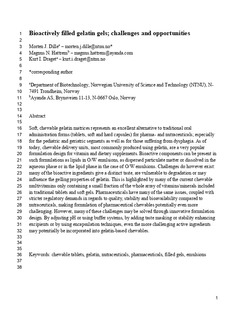| dc.contributor.author | Dille, Morten Johnsen | |
| dc.contributor.author | Hattrem, Magnus Nergård | |
| dc.contributor.author | Draget, Kurt Ingar | |
| dc.date.accessioned | 2019-04-12T07:46:41Z | |
| dc.date.available | 2019-04-12T07:46:41Z | |
| dc.date.created | 2019-01-17T12:47:24Z | |
| dc.date.issued | 2016 | |
| dc.identifier.citation | Food Hydrocolloids. 2018, 76 17-29. | nb_NO |
| dc.identifier.issn | 0268-005X | |
| dc.identifier.uri | http://hdl.handle.net/11250/2594385 | |
| dc.description.abstract | Soft, chewable gelatin matrices represent an excellent alternative to traditional oral administration forms (tablets, soft and hard capsules) for pharma- and nutraceuticals; especially for the pediatric and geriatric segments as well as for those suffering from dysphagia. As of today, chewable delivery units, most commonly produced using gelatin, are a very popular formulation design for vitamin and dietary supplements. Bioactive components can be present in such formulations as lipids in O/W emulsions, as dispersed particulate matter or dissolved in the aqueous phase or in the lipid phase in the case of O/W emulsions. Challenges do however exist: many of the bioactive ingredients give a distinct taste, are vulnerable to degradation or may influence the gelling properties of gelatin. This is highlighted by many of the current chewable multivitamins only containing a small fraction of the whole array of vitamins/minerals included in traditional tablets and soft gels. Pharmaceuticals have many of the same issues, coupled with stricter regulatory demands in regards to quality, stability and bioavailability compared to nutraceuticals, making formulation of pharmaceutical chewables potentially even more challenging. However, many of these challenges may be solved through innovative formulation design. By adjusting pH or using buffer systems, by adding taste masking or stability enhancing excipients or by using encapsulation techniques, even the more challenging active ingredients may potentially be incorporated into gelatin-based chewables. | nb_NO |
| dc.language.iso | eng | nb_NO |
| dc.publisher | Elsevier | nb_NO |
| dc.rights | Attribution-NonCommercial-NoDerivatives 4.0 Internasjonal | * |
| dc.rights.uri | http://creativecommons.org/licenses/by-nc-nd/4.0/deed.no | * |
| dc.title | Bioactively filled gelatin gels; challenges and opportunities | nb_NO |
| dc.type | Journal article | nb_NO |
| dc.type | Peer reviewed | nb_NO |
| dc.description.version | acceptedVersion | nb_NO |
| dc.source.pagenumber | 17-29 | nb_NO |
| dc.source.volume | 76 | nb_NO |
| dc.source.journal | Food Hydrocolloids | nb_NO |
| dc.identifier.doi | https://doi.org/10.1016/j.foodhyd.2016.12.028 | |
| dc.identifier.cristin | 1659272 | |
| dc.description.localcode | © 2016. This is the authors’ accepted and refereed manuscript to the article. This manuscript version is made available under the CC-BY-NC-ND 4.0 license http://creativecommons.org/licenses/by-nc-nd/4.0/ | nb_NO |
| cristin.unitcode | 194,66,15,0 | |
| cristin.unitname | Institutt for bioteknologi og matvitenskap | |
| cristin.ispublished | true | |
| cristin.fulltext | postprint | |
| cristin.qualitycode | 1 | |

